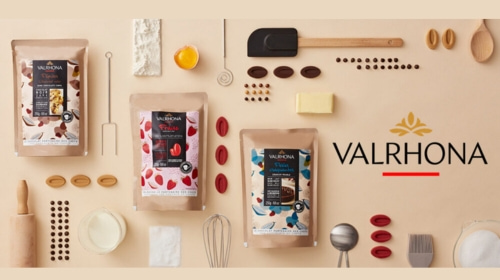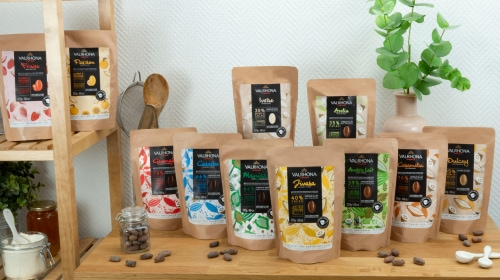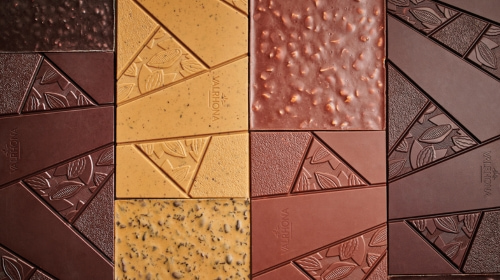Choosing a chocolate: Answers to the most frequently asked questions!
Which chocolate should I choose when making a cake? Can I use the same chocolate to make a mousse and a fondue? Which chocolates are healthy? Can I eat chocolate if I'm on a diet? Which chocolate is best for someone with diabetes?
When it comes to chocolate, a thousand questions are bouncing around people’s heads!
This article will finally reveal the secrets behind a good chocolate and will help you select one that matches your expectations, needs and desires.
But first, what is good chocolate?
We could say (truthfully) that a good chocolate is above all a chocolate that you like. Fortunately, more objective criteria exist to help you choose a truly good chocolate!

Good cocoa beans: the basis of good chocolate
Contrary to popular belief, it is not the percentage of cocoa that proves that a chocolate is of high quality, but the beans it is made from, their origin and the care taken throughout processing.
Harvested in two periods (from November to March and from May to July), cocoa beans are the seeds of cocoa pods and the fruit of the cacao tree, of which there are 3 varieties:
- Forastero tree: mainly found in the Amazon, it accounts for 80% of global cocoa bean production. To discover its flavors, try Valrhona’s Jivara 40% milk chocolate (Jivara 40% 250g bag), a recipe with creamy and vanilla hints.
- Criollo tree: with its softer, finer and more aromatic beans, Criollo is the rarest variety (only representing 2% of global production) and therefore the most sought after! The iconic Valrhona Guanaja 70% dark chocolate (Guanaja 70% 250g bag) is made from these beans. Taste it and let yourself be captivated by its unrivaled aromatic profile.
- Trinitario tree: a hybrid species, this cacao tree comes from a cross between the first two varieties. It is mainly found in Ecuador and Brazil. To discover its flavors, select the Caraïbe 66% blend of dark chocolate Grands Crus (Caraïbe 66% 250g bag) and be prepared for the surprise of the slightly woody sweetness of this highly popular chocolate.

A simple recipe: the secret to success!
While its production method requires significant expertise (bordering on alchemy), at its core, you don't need a thousand ingredients to make a good chocolate!
Cocoa beans, cocoa butter, sugar and vanilla are the main ingredients on the labels of all good chocolate worthy of the name.
If you are observant, you will notice that at Valrhona, we add soy or sunflower lecithin to our recipes. Why? Because these emulsifiers give chocolate a delicate, meltingly soft and crisp texture and allow aromas to be released more effectively without denaturing the chocolate.
The art of tasting
While its production method requires significant expertise (bordering on alchemy), at its core, you don't need a thousand ingredients to make a good chocolate!
Cocoa beans, cocoa butter, sugar and vanilla are the main ingredients on the labels of all good chocolate worthy of the name.
If you are observant, you will notice that at Valrhona, we add soy or sunflower lecithin to our recipes. Why? Because these emulsifiers give chocolate a delicate, meltingly soft and crisp texture and allow aromas to be released more effectively without denaturing the chocolate.
Ethics and traceability: another advantage!
Because control over the entire production chain guarantees quality, Valrhona has chosen to be what we call a “Bean To Bar” company. In other words, we handle every stage of our chocolate’s manufacturing process: hence “from bean to bar”.
Thus, we are now able to trace 100% of our cocoa from all 18,208 producers with whom we work.
We are committed to ensuring a fair income for everyone and have been carrying out projects for several years to support local communities (building schools, access to drinking water, etc.). These projects have enabled us to receive the B Corp certification (Valrhona is a certified B Corp), which recognizes companies that meet high social and environmental standards and are committed to progress.
The art of tasting
Now that you know how to recognize a good chocolate, here are some tips to learn how to taste it properly.
Get ready!
Above all, choose a quiet, well-lit place at room temperature.
Start by tasting the sweetest and least full-bodied chocolates.
Eat the chocolate in small quantities, and in two stages in order to better taste and analyze the flavors.
Chew slowly to accelerate the release of aromas.
Finally, drink a small sip of water between two tastings.
Awaken your senses!
Chocolate is like wine: there are different grapes, terroirs and châteaux. Each soil type will produce a unique bean that will vary depending on its climate, nature and soil quality.
As in oenology, tasting chocolate also involves hearing, smell and sight. So, you can judge the quality of a chocolate starting from when you break off a piece. A dry, clean snap will generally be a good sign. A smooth and shiny appearance will guarantee freshness. After defining the smell (powerful, marked, subtle, etc.) of the chocolate, we then taste it!
Woody, fruity, herbal, bitter, biscuity… Did you know that chocolate has more than 500 different aromatic notes? These aromas must remain on the palate several minutes after the end of the tasting. This is called a “long finish”.

There is a chocolate for every need, desire and state of mind.
How can you choose a good chocolate when you have specific needs and you are spoilt for choice?
We’ll help you to see more clearly by answering all your questions!
Which chocolate should you choose to bake with?
For your bakes (brownies, muffins, cakes, etc.), fondues and desserts (pastries, chocolate mousses, truffles, mendiants), opt for couverture chocolate. Why? Because this chocolate is specifically designed for baking! Top quality couverture chocolate contains more than 31% cocoa butter (compared to 26% for a classic “plain” chocolate). Its high fat content means it melts much faster and makes it easier to work with.
Valrhona’s couverture chocolate is popular with pastry professionals and big names in the pâtisserie sector, and can be tailored to your tastes and desires. Discover it in its dark chocolate version (Caraïbe 66% 250g bag), blond version (Dulcey 35% 250g bag), milk chocolate version (Jivara 40% 250g bag) and white chocolate version (Ivoire 35% 250g bag).
Like all chocolate, it is preferable to store it at a temperature between 65 and 70°F (18 and 20°C). Read our article on chocolate storage (how to store chocolate)
Which cocoa powder should you choose for hot chocolates?
Supermarket shelves are full of cocoa powder but beware, some of them can contain up to 80% sugar!
For your children’s breakfast or gourmet snacks, opt for a 100% unsweetened cocoa, which will be much healthier!
Low in carbohydrates, low in fat and incredibly high in antioxidants, cocoa powder with no added sugar is very interesting from a nutritional point of view.
While Valrhona’s unsweetened cocoa powder (Cocoa powder) is ideal for preparing hot or cold chocolate beverages, it is also perfect for decorating pastries, sprinkling toppings onto tiramisus, making mug cakes, coating chocolate truffles, as well as for enhancing savory dishes… and surprising your guests!
Now test your knowledge
Have you read it all? Are you now an expert when it comes to choosing the right chocolate? Let’s check with these 5 questions!
1/ Couverture chocolate is reserved for professionals.
False. Here’s the proof: you can get some couverture chocolate here! (Order your chocolate from Valrhona Collection)
2/ The quality of the chocolate depends solely on the percentage of cocoa.
False. It is the quality of the beans and the care given throughout processing that proves that a chocolate is of high quality!
3/ I can eat chocolate, even if I am on a diet.
True. Choose a chocolate with a high cocoa content, which is less sweet and do not eat more than 20g a day.
4/ The more ingredients there are in your chocolate, the better!
False: Cocoa beans, cocoa butter, sugar and vanilla are the main ingredients on your chocolate labels.
5/ There is no difference between couverture chocolate and baking chocolate.
False: Couverture chocolate is perfect for baking, but it's not baking chocolate! It is a high quality product, used by professionals and it is perfect for pastries, coatings, molded products, etc.
So, how many questions did you answer correctly?
 Microsoft Edge
Microsoft Edge
 Google Chrome
Google Chrome
 Mozilla Firefox
Mozilla Firefox
 Opéra
Opéra


